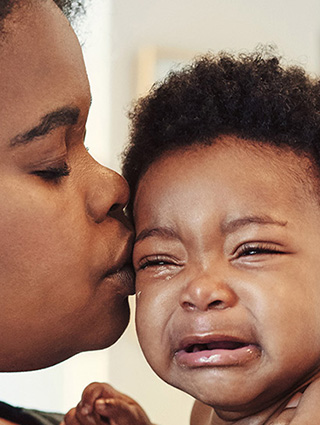Beginning at about 2 weeks, many babies start to cry more than they did when they were first born. This time is also sometimes called the "period of purple crying." Some babies cry a lot and others far less. This is the time to learn how to calm your baby and how to keep yourself calm if your baby won't stop crying. While it can be frustrating for parents, know that this time is temporary, and will probably end by the time baby is 3 or 4 months old. Be sure to watch for early hunger cues, because baby may be too upset to eat if he's been crying for a long time.
Try to figure out if there is a reason for the crying. Check:
- Does baby need to be burped?
- Does baby need a clean diaper?
- Does your baby have gas?
- Is baby too hot or cold?
- Is baby tired or sleepy?
- Is baby lonely or afraid?
- Is baby overstimulated?
- Is baby sick?
- Is baby hungry?
- Is baby in pain?
Respond to the problem by gently cuddling your baby and repeating the same action or motion. Try ONE of these at a time:

Speak or sing softly
Try saying a simple, calming phrase such as, "It's okay, baby. It's okay, baby. It's okay, baby."

Try movement
Gently rock, sway, or bounce your baby, repeating the same motion over and over again.

A Gentle Massage
Gently massage baby's back, arms, and legs.
If you think your baby may have gas
Try using the reverse football hold to comfort him. This position puts gentle pressure on baby's tummy, which can help get the gas out.
- Place baby lengthwise along your forearm facing down with his head next to your elbow.
- Place your hand between baby's legs and use your forearm for support.
- Use the palm of your hand to apply gentle pressure to the tummy.
- Use your other hand to gently rub and pat baby's back.
Be patient
Calming your baby takes time. Stick with the same action for several minutes—this can be the secret to success. If your baby continues to cry or becomes more upset, move on to something new.
It takes time to calm a crying baby.
It takes time to calm a crying baby. Know that during the first few months, some babies cry for no reason. They may cry for long periods of time even when they are well cared for and healthy. This can be very frustrating for parents.
- Ask a friend or family member to give you a break by helping with your baby.
- If you start to feel angry or overwhelmed, lay your baby down in a safe place for a few minutes and take a break. Do not ever shake your baby.
- Remember, things will get better. Babies cry less as they get older, and you will get through this!
- Contact WIC or your doctor if you think your baby is crying too much.




